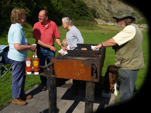
Cardiff
Naturalists' Society
Cymdeithas Naturiaethwyr
Caerdydd
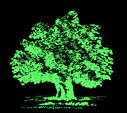
Colonel H. Morrey Salmon, CBE, MC, DL, DSc, (1890-1985) 72nd President
|
See blog posts about the Morrey Salmon photographic archive project Back to the 150th Anniversary index An Appreciation By Mairead Sutherland, Former President of the Society. Transcription of a lecture given to the Cardiff Naturalists’ Society on 4th January 2001. With the sudden death of Colonel H. Morrey Salmon on the 29th April 1985, in his 95th year, Wales lost its most eminent ornithologist and conservationist and the Cardiff Naturalists’ Society its most illustrious honorary and long serving member and the last link with the Society’s founder, Robert Drane. Morrey Salmon was born in 1890 and lived for a short time in Richmond Road, Cardiff before his family moved to Heol Don, Whitchurch, a suburb which, at that time, was surrounded by farmland and the busy Glamorganshire Canal. At that time another famous naturalist, Ronald Lockley, also lived in Heol Don and though the two men were to become very good friends later in life they never met when young. Perhaps it was because Ronald attended his mother’s private school, while Morrey attended Island Cottage Preparatory School beside the brook in Whitchurch, which is now a funeral home. This school was run by Miss Nell Evans, whose family were to play a major role in Morrey’s life. At school his best friend was Bert Evans who became his first bird-watching companion over many of his formative years and subsequently, his brother-in-law when, later, Morrey married his sister, Queenie. Morrey’s interest in birds was awakened, aged nine, when walking to school one day he found a blackbird’s nest with eggs, an interest which was to become an abiding life-long passion. He and Bert pursued their hobby on foot and by bicycle around the Cardiff environs, mainly Penylan, Rumney, Radyr and St-y-Nyll. Sometimes, they even cycled as far as Kenfig Pool carrying tents and food for a weekend’s birdwatching. When he was eighteen years old he bought his first camera, a quarter-plate Reflex. On the day that he acquired it he photographed a dipper’s nest under a bridge, over a stream which ran into the River Rumney. The same afternoon, Bert and he climbed up to a rook’s nest and he took four photographs of the inside of the nest. With his camera, he could now combine his written records with photographs. By the age of twenty, he had become such a proficient photographer that he was accepted as a member of the prestigious Zoological Photographic Club. Indeed, in his late eighties he was requested by the club to submit some of his work from 1909-1911. 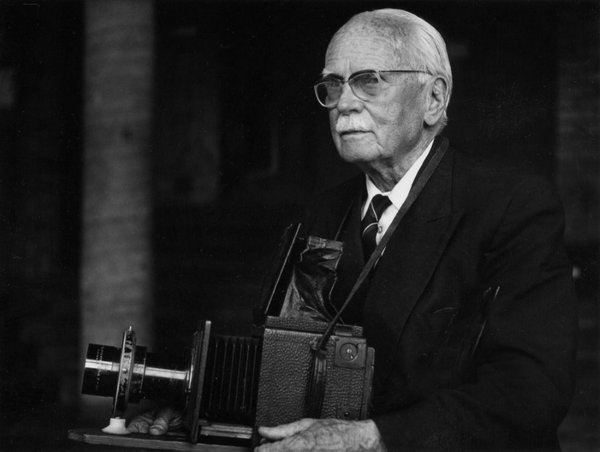
Salmon and camera taken in 1981 Rarely satisfied with the performance of any of his cameras, Morrey usually added his own refinements, which were mostly home made. His first adaptation was an electrically operated release so that he could hide his camera in a bush near a nesting bird and, from a distance, make his exposure with minimum disturbance to the bird by way of a long piece of flex. He pioneered long focal lens photography when he moved on to photographing birds away from the nest in their natural habitat and later, together with Arthur Brooke, experimented with flash photography. Their flash unit consisted of an old sardine box, filled with magnesium powder which was mixed to their own formula, which was ignited by a piece of fuse wire connected to a torch battery. This “Heath Robinson” contraption produced some memorable shots of nocturnal birds. To make enlargements of his photographs, for exhibition and illustrating scientific papers, he acquired an old magic lantern and gradually, over a period of months, converted it into an enlarger using an old bellows camera body and lens. Though modified from time to time it was still operational in his dark room until he moved to a modern enlarger for 35mm film. With his schooling over Morrey had hoped to enter university to study Zoology but, being the eldest son, his father, Edgar Salmon (46th President), who owned the South Wales India Company in West Bute Street, required him to join the business. While there Morrey met Geoffrey C S Ingram 53rd President, who also worked at the docks and who was also a keen ornithologist and so was formed a most memorable working partnership and meeting of minds which lasted for sixty years, until Ingram’s death. In 1867 Robert Drane, a naturalist and antiquarian, founded the Cardiff Naturalists’ Society. It was the first scientific society in Wales and its aim was to interest Welsh people in the natural sciences and to found a National Museum of Wales. The Society drew its members from the business and professional people of the town. Morrey’s father became a prominent member and fostered his son’s interest in natural history. He introduced him to Robert Drane, who helped and encouraged the young man and, when he and Geoffrey Ingram joined in 1910, there began a seventy four-year involvement with the Society. 
Salmon and Ingram on the Road post 1921 when Salmon purchased a car - a 1920 Gofrey Nash In his first year of membership he read a paper to the Parent Society, which he illustrated with seventy lantern slides of Welsh birds. Soon, both he and Geoffrey were submitting bird records to Thomas William Proger and Donald Rose Paterson, who published Bird Notes, in the annual Transactions of the Society. When those men retired, the partners continued this work from 1917-1952, when Geoffrey’s sight failed and then Morrey continued alone until the Transactions ceased publication with the centenary volume in 1987. 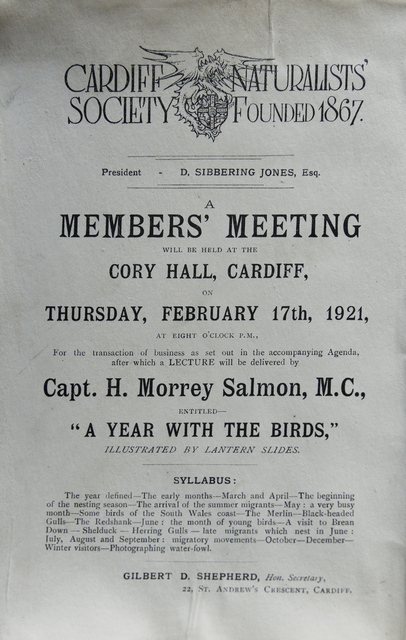
Lecture Programme from 1921 - Morrey Salmon's First lecture to the society In 1909, Morrey joined the 7th (Cyclist) Battalion, the Welsh Regiment. With the outbreak of war in 1914 he was commissioned while serving in France where he was mentioned in dispatches and was awarded the Military Cross and Bar. After the war he returned to Cardiff to become a director of the family business and to renew his association with Geoffrey Ingram. During the ensuing years, the partners produced their most productive work. In 1925 they revised the Birds of Glamorgan, first published by Proger and Paterson in the Transactions in 1900, and they contributed a weekly article on birds to the Western Mail from 1927-1939. They next embarked on publishing a record of their work to date. With extracts from their Bird Notes they published Birds in Britain today in 1933, which they illustrated with their own photographs. It became a best seller and even today is highly regarded and sought after in antiquarian bookshops and catalogues. 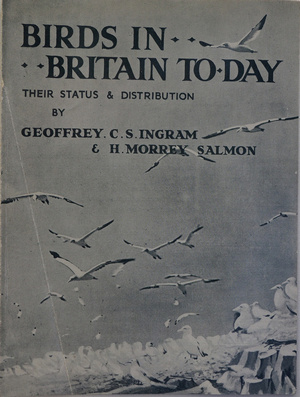
Birds in Britain Today In 1935 their article on the Birds of Glamorgan was included in the Glamorgan County History, Volume 1, Natural History. Following this they drew on their wealth of data gleaned on their extensive travelling and correspondence with bird recorders all over Wales, to produce hand-lists on the birds of every county. It was Morrey’s proud boast that, over seventy years he had covered every road, lane or track in Wales, on foot, bicycle or by car, in pursuit of his hobby. Joshua John Neale, owner of fishing trawlers and a member of Cardiff Naturalists’ Society, leased the Pembrokeshire islands of Skomer and Grassholm from 1890-1915 and occasionally invited fellow members to join him for long weekends. Salmon and Ingram often visited the islands and spent many long periods over there as members of the Pembrokeshire Field Club. At the same time Ronald Lockley was farming on Skokholm, which he had also leased. He invited Salmon and Ingram to help him record the natural history of the islands. Gannets were nesting on Grassholm and Lockley and Salmon decided to take a photographic census of the now large colony. On one occasion it took them ten hours to row from Skokholm to Grassholm but, by using his skills with a camera in choppy seas, Morrey completed the census. The pictures were marked off in squares and the birds within each square counted. The results were published in British Birds. Morrey Salmon’s most memorable contribution to the knowledge of nocturnal birds was obtained on Skokholm. He was the first person to record the nocturnal habits of shearwaters and storm petrels, using flash photography. A selection of these photographs, together with a flash photograph showing a swift returning to its nest with its pouch filled with insects and other early photographs, were chosen for the book Masterpieces of Bird Photography. These are now form part of the Nature Conservancy Council’s (now English Nature) national collection. 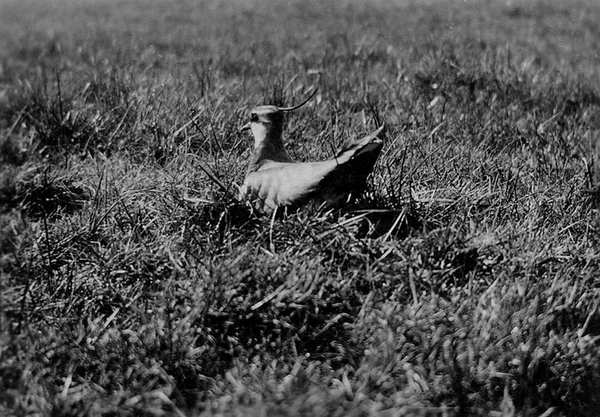
Lapwing by Morrey Salmon - His first photograph of a nesting bird in 1909 At Lockley’s invitation Morrey, his wife and family, spent frequent holidays on Skokholm and, when Lockley embarked on building a Heligoland trap on the island, he had the willing help from Salmon and Ingram. When it was completed five willow warblers were the first birds trapped. By way of thanks for their help with this project, Lockley allowed them to ring the first two birds while he ringed the other three. With the completion of this trap Skokholm became the first migrant marking station ever established. With the outbreak of hostilities in 1939, Morrey immediately offered his services to the Welsh Regiment. Considered too old for active service at 48 he became a training officer with the rank of Captain. In 1940 he was seconded to the RAF to set up the Royal Airforce Regiment and was made a full Colonel. In 1942 he served in Algeria, Tunisia and Libya in North Africa and was promoted to Commandant of the whole Mediterranean arena. He organised the troops, which fought their way through Sicily and Italy to liaise with the British regiments. When peace was restored, he was awarded the CBE and retained his association with the Welsh regiment, which always held a very important role throughout his life. He was in charge of the Regiment’s medal collection and was also involved in the setting up of the Welsh Regiment Chapel in Llandaff Cathedral. With his father’s death, Morrey had taken over the business but after the war he employed a full time manager to run it on a day to day basis which left him more time to devote to his many and varied interests. He represented the Cardiff Naturalists’ Society on the Nature Conservancy Committee for Wales (1951-1966) and also served on The Nature Conservancy Council (1957-1960), the Conservation Committee and Council of the Royal Society for the Protection of Birds, the Council for the Protection of Rural Wales, the Environment Foundation and the Prince of Wales Trust. He was a founder member of the Glamorgan Trust for Nature Conservation and a life member of the British Ornithologists’ Union. Most ornithologists will best remember Morrey for his conservation work and services to bird protection, especially for the major role that he played as a member over fifty years of the Kite Committee. Members of this committee guarded the small, relict population and habitat of the rare red kite in Mid Wales. In 1970 he wrote the story of their preservation in Welsh Wildlife in Trust, edited by W.S.Lacey. However, his definitive account of their near extinction from three nests in 1882 to their recovery, is documented in A history of the kite Milvus milvus (L) in Wales. There are only three copies of this confidential document, which contains detailed distribution maps of nest sites; one is in the safe keeping of the National Museum of Wales and the second is held by the Nature Conservancy Council. Morrey Salmon presented the third copy to the RSPB in 1971 when they awarded him their Gold Medal in recognition of his conservation work and services to bird protection in Wales. In his book, The Kite’s Tale (1990), Roger Lovegrove says “nobody who attempts to write the history of the red kite’s protection in Wales can do other than draw substantially on the masterly work of scholarship which was produced by the late Colonel H.Morrey Salmon, doyen of Welsh ornithologists and intimately involved at the heart of kite affairs for over fifty years. In addition he was personally acquainted with all the major personalities involved across that period”. In William Condry’s book Wildlife my Life (1995) he says of Morrey Salmon “ask him about a record of any kite’s nest in Member of the Court of Governors. The Cardiff Naturalists’ Society also had a special relationship with the museum as a result of the Society’s memorial to the Privy Council in support of the location of the National Museum in Cardiff, which was granted in 1907. This special relationship was nurtured by Morrey, who obtained concessions from the museum for the use of the Reardon Smith Lecture Theatre for Society lectures. The Society was also granted permission to hold its Council meetings in the Court Room of the museum and enjoyed the very fine facilities of the museum’s main hall for its Presidential Receptions. 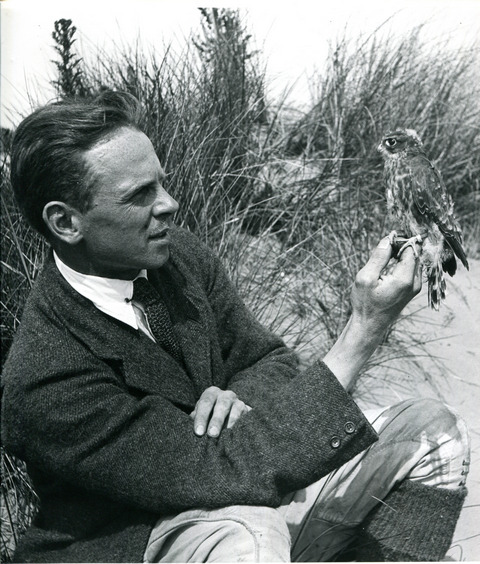
Salmon and Young Merlin In 1976, the museum mounted an exhibition of his photographs. In 1982, in celebration of the 75th anniversary of the granting of the museum’s Royal Charter of Incorporation in 1907, an exhibition entitled 75 Years of Ornithology in Wales was displayed. Although intended mainly as a tribute to Morrey’s work he, with his well-known modesty, insisted on the work of other Welsh photographers being included. In a letter to me at the time he wrote “I am beginning to feel that, if I have to face my own name in such large type, every time I go into the Museum for the next three months, I shall have to use the back door.” Morrey’s conservation work in his native Wales was recognised by the University of Wales in 1982 when they awarded him the degree of Doctor of Science honoris causa, the highest accolade in the scientific world. It was a fitting reward for the eighty-four years that he had dedicated himself to the nature of Wales. It is difficult not to present a mere catalogue of Morrey’s achievements but to do so would give no idea of the warm personality of the man. He was first and foremost a family man and was never happier than when he and his wife acted ‘in loco parentis’ for his five grandchildren during their short school holidays as both his sons were in overseas posts. His wife shared his interests and travelled extensively with him on visits to ‘the boys’. His eldest son, Norman, is a Major in the army and served in Hong Kong, Libya, Germany, Zimbabwe and Cyprus. While visiting him in Cyprus, Morrey wanted to photograph the nests of Audouin’s gulls but could get no boat to take him to the uninhabited Klides Islands. Never one to accept defeat he loaded his equipment on to a little lilo and sent Norman swimming with it to the island. When he was sure that Norman had made land he swam the half mile to the island himself, where he successfully photographed the birds. Not much you might think except that he was eighty-four years old at the time! His younger son, Hugh, was in the British Council and had postings in Uganda, Nigeria, Pakistan, Peru, Malta, Egypt and the Phillipines. All of these foreign outposts gave Morrey further scope for studying and photographing new avifauna. We in the Society looked forward to these travels as we were always sure of an interesting slide show on his return. He once told us that he had photographed birds on every continent except the Antarctic and Arctic and, had he been spared, I’m sure that he would have added these to his triumphs. Morrey had a wide national and international circle of friends. Those of us lucky enough to be included in that category will have fond memories of the pleasurable times spent with this extraordinary, gifted raconteur. I often burned the midnight oil in his company forgetting all time as he conjured up happy tales and memories of days spent in the field with naturalists of yesteryear. All of us will remember his generosity in respect of the time that he was prepared to devote to helping others in all aspects of the natural world. Nothing was too much trouble and he could draw on his encyclopaedic memory for dates of importance and people concerned in the ornithological world, spanning the best part of a century. Even today his influence and friendship is sadly missed. His constitution was legend. I never saw him wear a coat on the coldest day, whether in the field or in town. His army pullover and jacket sufficed. During his eightieth year he fell out of his apple tree while pruning it, blaming a rotten rung in his ladder but he was soon active again. At his 90th birthday party, when most of us were feeling a little fragile late at night, he was still going strong. Death came suddenly with a massive heart attack. Though the shock was great it was comforting to read in his last letter, which I had received that morning, that he had been watching from his study window, a robin building its nest in his laurel hedge. Birds were still giving him pleasure to the end. His funeral was held in Llandaff Cathedral and was attended by a large congregation of the great and the good. The Lord Lieutenant, Sir Cenydd Traherne, Dr Douglas Bassett, the Director of the National Museum of Wales, and representatives from Her majesty’s Forces gave orations, and all the papers carried obituaries. He now rests beside his beloved wife, Queenie, in the churchyard of St Mary’s in Whitchurch, where his long journey of the best part of a century began. Lives of great men all remind us
Henry Wadsworth Longfellow (1807-82) An External site that has some more information about Morrey Salmon is Notes from the river bankBack to the 150th Anniversary index Before this... William Rees, M.A., D.Sc., F.S.A.. F.R.HIST.S.. D.LITT. 71st President Next up... Aubrey H. Jenkins A.R.P.S. 73rd President These pages are part of the Cardiff Naturalists' Society 150th Anniversary celebrations and are about our history and are celebrating the people who developed our Society and helped build the city and the cultural heritage of Cardiff. You can read more about that using the links above If you want to read about the ways we study the wildlife and environment of the Cardiff area and its surroundings, and about the talks we have about the wildlife of the world, and find the programme of talks, walks and other events that we do then please take a look at our main website, our blog and our facebook and twitter feeds for up to date news |